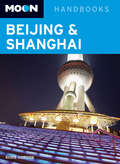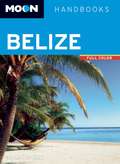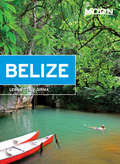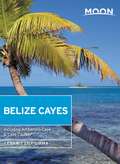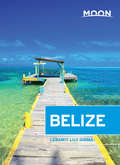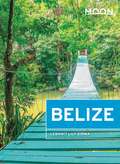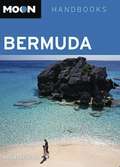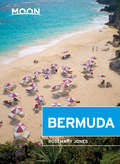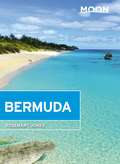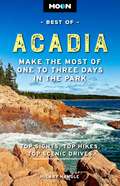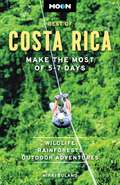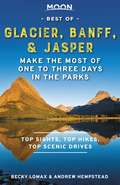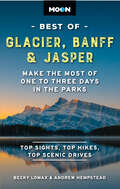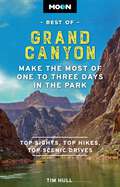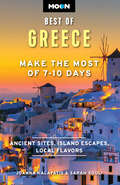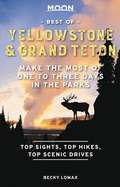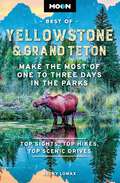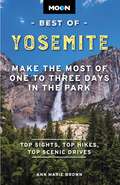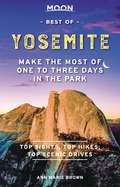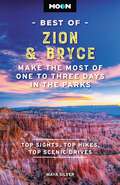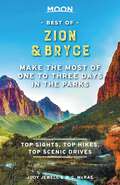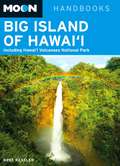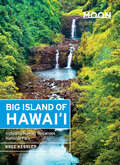- Table View
- List View
Moon Beijing & Shanghai
by Susie GordonJournalist Susie Gordon offers her insider's perspective on Beijing and Shanghai, from experiencing the grandeur of the Forbidden City and slurping noodles at the open-air night market in Wangfujing to shopping in People's Square and strolling through Old French Concession. Gordon also includes many unique travel strategies, including Essential Beijing, Whistle-Stop Shanghai, and City Contrasts-a 10-day itinerary for a tour of both cities. From Beijing's well-preserved old hutong alleys to Shanghai's ultra-modern Pudong district,Moon Beijing & Shanghaigives travelers the tools they need to create a more personal and memorable experience.
Moon Belize
by Lebawit Lily GirmaThis full-color guide to Belize includes vibrant photos and helpful planning maps.Travel writer, photographer, and Belize expert Lebawit Lily Girma knows the best ways to experience Belize-from the gorgeous beaches of the Northern Cayes to the diversity of the Cockscomb Wildlife Sanctuary and Jaguar Preserve (the only jaguar preserve in the world). Girma offers a range of interesting activities for every traveler-such as waterfall rappelling at Bocawina National Park or attending the Chocolate Festival-as well as unique trip ideas like A 14-Day Cultural Tour. Packed with information on dining, transportation, and accommodations, Moon Belize gives travelers the tools they need to create a more personal and memorable experience.This ebook and its features are best experienced on iOS or Android devices and the Kindle Fire.
Moon Belize
by Lebawit Lily GirmaThis full-color guide includes vibrant photos and easy-to-use maps to help with trip planning.Travel writer, photographer, and Belize expert Lebawit Lily Girma knows the best ways to experience Belize-from the gorgeous beaches of the Northern Cayes to the lush countryside of Belmopan and Cayo. Girma offers a range of interesting activities for every traveler-such as waterfall rappelling at Bocawina National Park or attending the annual Chocolate Festival-as well as unique trip ideas such as the "Rhythms of Belize." Packed with information on dining, transportation, and accommodations, Moon Belize gives travelers the tools they need to create a more personal and memorable experience.
Moon Belize Cayes: Including Ambergris Caye & Caye Caulker (Travel Guide)
by Lebawit Lily GirmaThis full-color guide to Belize Cayes includes vibrant photos and helpful planning maps.Travel writer, photographer, and Belize expert Lebawit Lily Girma shares the best ways to experience these stunning islands. Girma offers a range of interesting activities for every traveler-whether they're avid snorkelers, beach bums, aspiring divers, honeymooners, or simply on a budget-as well as unique features like an underwater guide to exploring the sea life of Belize. Packed with information on dining, transportation, and accommodations, Moon Belize Cayes gives travelers the tools they need to create a more personal and memorable experience.
Moon Belize: Including Ambergris Caye & Caye Caulker (Travel Guide)
by Lebawit Lily GirmaMoon Travel Guides: Your World Your WayWith turquoise waters, dreamlike islands, and pristine rainforests, Belize is a sensory feast: dive in with Moon Belize.Inside you'll find:Flexible, strategic itineraries for every timeline and budget, from one week of highlights to a three-week adventure through the whole country, with themed trip ideas like "The Mundo Maya," "Wildlife Adventures," and "Underwater Bliss"Curated advice for outdoor adventurers, archeology aficionados, foodies, and moreMust-see attractions and off-beat ideas for making the most of your trip: Canoe to a farmers market to sample fresh pupusas and cashew wine. Hike rainforests filled with medicinal trees and howler monkeys, snorkel the second-largest (and best preserved) coral reef in the world, or explore ancient Mayan ceremonial caves and cool off beneath the waterfalls. Spend your day at the beach, and your night dancing barefoot in the sand to the sound of Garifuna drumsExpert advice on when to go, what to pack, and where to stay, from Belize transplant-turned-local Lebawit Lily Girma Full-color photos and detailed maps for navigating the cayes and mainland on your ownHandy phrases in Kriol, Garifuna, and Q'eqchi' MayanDetailed background information on the landscape, climate, wildlife, and cultureTravel tips on health and safety, traveling solo as a woman, getting around with children or as a senior, and suggestions for LGBTQ+ visitors and travelers with disabilitiesWith Moon Belize's expert tips, myriad activities, and local insight, you can plan your trip your way.Planning an island getaway? Pick up Moon Belize Cayes. Looking to expand your trip? Try Moon Yucatán Peninsula, Moon Guatemala, or Moon Jamaica.
Moon Belize: Including Ambergris Caye & Caye Caulker (Travel Guide)
by Lebawit Lily GirmaWith turquoise waters, dreamlike islands, and pristine rainforests, Belize is a sensory feast. Dive in with Moon Belize. Inside you'll find:Flexible itineraries, from the weeklong best of Belize to three weeks exploring the whole country Strategic advice for water sports lovers, foodies, wildlife enthusiasts, and more, plus suggestions for supporting local businesses and exploring ethically and sustainablyThe top outdoor adventures: Hike rainforests filled with medicinal trees and howler monkeys, snorkel the second-largest coral reef in the world, go spelunking in ancient underground caves, or hop through the vibrant cayesUnique experiences and can't-miss highlights: Canoe to a farmers market to sample fresh pupusas and cashew wine, and cool off beneath the waterfalls. Marvel at Mayan archaeological sites or experience a traditional homestay in Punta Gorda. Relax on the beach all day, and spend your night dancing barefoot in the sand to the sound of Garifuna drumsHonest advice on when to go, what to pack, and where to stay, from Belize expert Lebawit Lily GirmaFull-color photos and detailed maps throughoutEssential background on the landscape, climate, wildlife, and culture, plus handy phrases in Kriol, Garifuna, and Q'eqchi' MayanHelpful recommendations for health and safety, traveling solo, and suggestions for LGBTQ visitors, travelers with disabilities, and seniorsExperience the best of Belize with Moon's expert tips and local insight.Looking to expand your trip? Try Moon Yucatán Peninsula or Moon Costa Rica.
Moon Berlin Walks
by Moon Travel GuidesExperience Berlin like a local: on foot! Moon Berlin Walks reveals Berlin's thriving art scene, palpable history, and unique vibe by guiding you to the city's unmissable hotspots and trendiest locales. This full-color guide features: Six customizable walks through the city's hippest neighborhoods, including Kreuzberg, Prenzlauer Berg, Shöneberg, and more, with color-coded stops and turn-by-turn directions; Foldout maps of each route and a removable full-city map, in a handy, portable guide; Curated "Top Ten" lists for restaurants, street food, nightlife, and Sunday activities for visitors looking to hit the highlights; The top attractions and the best-kept local secrets: Stumble upon the newest, hippest coffee shop in Prenzlauer, or kick back in a popular public park. Discover your favorite currywurst or kebap stand, or sample schnitzel, spätzle, and brews at a biergarten. Peruse vintage knick-knacks at a Sunday flea market, and admire the works of art along the East Side Gallery. Browse world-class museums, or head to historical sites like Checkpoint Charlie. Dance the night away to an up-and-coming DJ set in an open-air club or underground warehouse party, or sip craft cocktails at a brand-new rooftop bar overlooking the city. Public transportation options, including the subway, bus, taxi, or bike rental. Tips for first-time visitors, including navigating nightlife, where you'll need to make a reservation, and getting to and from the airport. With creative routes, public transit options, and a full-city map, you can explore Berlin at your own pace, without missing a beat.
Moon Berlin Walks (Travel Guide)
by Moon Travel GuidesExperience Berlin like a local: on foot!Moon Berlin Walks reveals Berlin's thriving art scene, palpable history, and unique vibe by guiding you to the city's unmissable hotspots and trendiest locales. This full-color guide features:Six customizable walks through the city's hippest neighborhoods, including Kreuzberg, Prenzlauer Berg, Shöneberg, and more, with color-coded stops and turn-by-turn directionsFoldout maps of each route and a removable full-city map, in a handy, portable guideCurated "Top Ten" lists for restaurants, street food, nightlife, and Sunday activities for visitors looking to hit the highlightsThe top attractions and the best-kept local secrets: Stumble upon the newest, hippest coffee shop in Prenzlauer, or kick back in a popular public park. Discover your favorite currywurst or kebap stand, or sample schnitzel, spätzle, and brews at a biergarten. Peruse vintage knick-knacks at a Sunday flea market, and admire the works of art along the East Side Gallery. Browse world-class museums, or head to historical sites like Checkpoint Charlie. Dance the night away to an up-and-coming DJ set in an open-air club or underground warehouse party, or sip craft cocktails at a brand-new rooftop bar overlooking the cityPublic transportation options, including the subway, bus, taxi, or bike rentalTips for first-time visitors, including navigating nightlife, where you'll need to make a reservation, and getting to and from the airportWith creative routes, public transit options, and a full-city map, you can explore Berlin at your own pace, without missing a beat.Check out our guides to more of the world's liveliest cities, so you can hit the ground running! Also available: Moon Barcelona Walks, Moon New York Walks, Moon London Walks, Moon Amsterdam Walks, Moon Paris Walks, and Moon Rome Walks
Moon Bermuda
by Rosemary JonesFrom shopping for duty-free treasures in the capital of Hamilton to exploringt. George's (home of the island's first settlers) to lounging in luxuriouseachfront hotels, "Moon Bermuda" is the guide to the best the island has toffer, both on and off the beaten path. With firsthand experience and honestnsight, Bermuda native Rosemary Jones provides you with all the tools youeed to create your own unique experience. Rosemary's fun and creative traveluggestions can help you plan your perfect trip: Complete with details forollowing the African Diaspora Trail, attending the renowned Internationalilm Festival in the spring, or touring the island's protected marine areasnd 63 national parks, "Moon Bermuda" gives travelers the tools they need. ith expert writers, first-rate strategic advice, and an essential dose ofumor, "Moon Handbooks" ensure that travelers have an uncommon and entirelyatisfying experience - and a few new stories to tell.
Moon Bermuda
by Rosemary JonesBermuda native Rosemary Jones provides her firsthand insight into the best this balmy island has to offer, from shopping for duty-free treasures in the capital of Hamilton to exploring St. George's, home of the island's first settlers. Jones also offers creative travel ideas, such as Vacation with the Kids, On the Wild Side, and A Romantic Retreat. With expert advice on lounging on pink-sand beaches, golfing at the famous Mid Ocean Club, and scuba-diving on shipwrecks, Moon Bermuda gives travelers the tools they need to create a more personal and memorable experience.This full-color guide includes vibrant photos and helpful maps.
Moon Bermuda (Travel Guide)
by Rosemary JonesImpossibly turquoise bays, pink sands, and hibiscus-scented breezes: go with the flow and experience a fantasy come to life with Moon Bermuda. Inside you'll find:Strategic itineraries designed for honeymooners, families, outdoor adventurers, history buffs, and moreUnique experiences and can't-miss highlights: Stroll the soft sands of Elbow Beach, dive to underwater shipwrecks, and splash around in the warm waves. Spend a morning browsing Hamilton's boutiques and historic churches, and stroll the colorful Bermuda Botanical Gardens. Spot ring-tailed lemurs, seahorses and sharks at the Bermuda Aquarium, Museum & Zoo, and visit the incredible formations of Crystal Cave. Watch the sun go down over the Harrington Sound as you dine al fresco on fresh seafood and cassava fries, and relax at a beachfront bar with a rum swizzleAdvice on outdoor activities, from golf to watersports, including scuba diving, snorkeling, waterskiing, wakeboarding, and flyboardingHonest recommendations from local Rosemary Jones on when to go, where to eat, how to get around, and where to stay, from waterfront cottages and luxurious resorts to budget hotelsFull-color photos and detailed maps throughoutPractical background on Bermuda's landscape, culture, history, and environmentHandy information for families, seniors, travelers with disabilities, LGBTQ+ travelers, and visitors planning a wedding, as well as volunteer opportunitiesWith Moon Bermuda's expert tips and local know-how, you can plan your trip your way.Island-hopping around the Caribbean? Try Moon Dominican Republic, Moon Aruba, or Moon Jamaica.
Moon Best of Acadia: Make the Most of One to Three Days in the Park (Travel Guide)
by Hilary NangleWhether you're visiting the park for a day hike or spending a long weekend under the stars, escape to the great outdoors with Moon Best of Acadia National Park. Inside you'll find:Easy itineraries for one to three days in Acadia National Park, from a morning drive along the Park Loop Road, to a day hike on Cadillac Mountain, to a full weekend exploring the park The top hikes in Acadia: Whether you're looking to stretch your legs for a couple hours or challenge yourself to a full day hike, you'll find trailheads, detailed trail descriptions, individual maps, mileage, and elevation gains Can't-miss experiences: Make it the perfect getaway with the best views, picnic spots, and more. Embark on a whale-watching excursion or hike along the secluded rocky shore of Isle de Haut. Sea kayak at sunset, take a leisurely bike ride through fiery fall foliage, or marvel at the tide roaring through Thunder Hole Stunning full-color photos and detailed maps throughout, plus a full-color foldout mapEssential planning tips: Find out when to go, where to stay, and what to pack, plus up-to-date information on entrance fees, reservations, and safety advice Expert insight from born-and-bred Mainer Hilary Nangle Make the most of your adventure with Moon Best of Acadia National Park. Planning a longer trip? Pick up Moon Maine. Visiting more of North America's incredible national parks? Try Moon USA National Parks.About Moon Travel Guides: Moon was founded in 1973 to empower independent, active, and conscious travel. We prioritize local businesses, outdoor recreation, and traveling strategically and sustainably. Moon Travel Guides are written by local, expert authors with great stories to tell—and they can't wait to share their favorite places with you. For more inspiration, follow @moonguides on social media.
Moon Best of Costa Rica: Make the Most of 5-7 Days (Travel Guide)
by Nikki SolanoFrom waterfalls and cloud forests to white sand beaches, a week of pura vida awaits with Moon Best of Costa Rica. Inside you&’ll find:Flexible, strategic itineraries: Choose the best home base for you with regional five-day itinerary options or combine shorter side trips for a week of exploring The top adventures: Discover the best wildlife and marine life experiences, waterfalls, beaches, rainforests and cloud forests, ziplines, surf spots, and more Authentic can&’t-miss experiences: Swim under a waterfall, raft over rapids, and explore mysterious caves. Admire the forest floor from the middle of a hanging bridge, take an aerial tram with incredible views, or snorkel with sea turtles in warm turquoise water. Relax on a pristine beach, soak in a volcanic mineral pool, and watch the sunrise with a cup of flavorful local coffee Insight from Cartago local Nikki Solano on how to experience Costa Rica like an insider, support local and sustainable businesses, avoid crowds, and respectfully engage with the culture Helpful charts with travel times from San Jose or Liberia international airports Full-color photos and detailed maps throughoutBackground information on Costa Rica's wildlife, landscape, history, and cultural customs, plus travel essentials like a packing list and health and safety information With Moon's selective coverage and strategic tips, you can experience the best of Costa Rica. Planning to stay more than a week? Check out Moon Costa Rica.About Moon Travel Guides: Moon was founded in 1973 to empower independent, active, and conscious travel. We prioritize local businesses, outdoor recreation, and traveling strategically and sustainably. Moon Travel Guides are written by local, expert authors with great stories to tell—and they can't wait to share their favorite places with you. For more inspiration, follow @moonguides on social media.
Moon Best of Glacier, Banff & Jasper: Make the Most of One to Three Days in the Parks (Travel Guide)
by Becky Lomax Andrew HempsteadWhether you're stopping for a day hike or spending a long weekend under the stars, escape to the great outdoors with Moon Best of Glacier, Banff & Jasper. Inside you'll find:Easy itineraries for one to three days in Glacier, Banff, and Jasper National Parks, from a scenic drive along Going-to-the-Sun Road, to a day of hiking through glacial valleys, to a weekend exploring the best of all three parks with mix-and-match itinerariesThe top hikes in Glacier, Banff, and Jasper: Whether you're looking to stretch your legs for a couple hours or challenge yourself to an epic trek, you'll find trailheads, detailed trail descriptions, individual maps, mileage, and elevation gainsCan't-miss experiences: Make it the perfect getaway for you with the best views, picnic spots, and more. Trek through fields of alpine wildflowers, walk beneath waterfalls, get your adrenaline pumping on the Glacier Skywalk, and spot wild moose or grizzlies roaming the mountainsideStunning full-color photos and maps throughout, plus a full-color foldout mapEssential planning tips: Find out when to go, where to stay, and what to pack, plus up-to-date information on entrance fees, border crossing, reservations, and safety adviceKnow-how from outdoors experts Andrew Hempstead and Becky LomaxMake the most of your adventure with Moon Best of Glacier, Banff & Jasper.Visiting more of North America's incredible national parks? Try Moon USA National Parks. About Moon Travel Guides: Moon was founded in 1973 to empower independent, active, and conscious travel. We prioritize local businesses, outdoor recreation, and traveling strategically and sustainably. Moon Travel Guides are written by local, expert authors with great stories to tell—and they can't wait to share their favorite places with you.For more inspiration, follow @moonguides on social media.
Moon Best of Glacier, Banff & Jasper: Make the Most of One to Three Days in the Parks (Travel Guide)
by Becky Lomax Andrew Hempstead Moon Travel GuidesWhether you're stopping for a day hike or spending a long weekend under the stars, escape to the great outdoors with Moon Best of Glacier, Banff & Jasper. Inside you'll find:Easy itineraries for one to four days in Glacier, Banff, and Jasper national parks, from a scenic drive along Going-to-the-Sun Road, to a day of hiking through glacial valleys, to a weekend exploring the best of all three parks with mix-and-match itinerariesThe top hikes in Glacier, Banff, and Jasper: Whether you're looking to stretch your legs for a couple hours or challenge yourself to an epic trek, you'll find trailheads, detailed trail descriptions, individual maps, mileage, and elevation gains Can't-miss experiences: Make it the perfect getaway for you with the best views, picnic spots, and more. Trek through fields of alpine wildflowers, walk beneath waterfalls, get your adrenaline pumping on the Glacier Skywalk, and spot wild moose or grizzlies roaming the mountainside Stunning full-color photos and maps throughout, plus a full-color foldout mapEssential planning tips: Find out when to go, where to stay, and what to pack, plus up-to-date information on entrance fees, border crossing, reservations, and safety advice Know-how from outdoors experts Andrew Hempstead and Becky LomaxMake the most of your adventure with Moon Best of Glacier, Banff & Jasper. Visiting more of North America's incredible national parks? Try Moon USA National Parks. Spending more time in Glacier? Try Moon Glacier National Park.About Moon Travel Guides: Moon was founded in 1973 to empower independent, active, and conscious travel. We prioritize local businesses, outdoor recreation, and traveling strategically and sustainably. Moon Travel Guides are written by local, expert authors with great stories to tell—and they can't wait to share their favorite places with you.
Moon Best of Grand Canyon: Make the Most of One to Three Days in the Park (Travel Guide)
by Tim HullWhether you're stopping for a day hike or spending a long weekend under the stars, escape to the great outdoors with Moon Best of Grand Canyon. Inside you'll find:Easy itineraries for one to three days in Grand Canyon National Park, from a morning bike ride along the South Rim, to a day hike in the inner canyon, to a full weekend exploring the park The top hikes in Grand Canyon: Whether you're looking to stretch your legs for a couple hours or challenge yourself to an epic trek, you'll find trailheads, detailed trail descriptions, individual maps, mileage, and elevation gains Can't-miss experiences: Make it the perfect getaway for you with the best views, scenic drives, picnic spots, and more. Trek into Havasu Canyon to see stunning waterfalls or drive to viewpoints along Hermit Road. Go on a rafting adventure on the Colorado River and spot wildlife like elk and bighorn sheep Stunning full-color photos and maps throughout, plus a full-color foldout mapEssential planning tips: Find out when to go, where to stay, and what to pack, plus up-to-date information on entrance fees, reservations, and safety advice Helpful resources on Covid-19 and visiting the Grand Canyon Know-how from Arizona local and Grand Canyon expert Tim HullMake the most of your adventure with Moon Best of Grand Canyon. Visiting more of North America's incredible national parks? Try Moon USA National Parks. About Moon Travel Guides: Moon was founded in 1973 to empower independent, active, and conscious travel. We prioritize local businesses, outdoor recreation, and traveling strategically and sustainably. Moon Travel Guides are written by local, expert authors with great stories to tell—and they can't wait to share their favorite places with you. For more inspiration, follow @moonguides on social media.
Moon Best of Greece: Make the Most of 7-10 Days (Travel Guide)
by Sarah Souli Joanna KalafatisFrom ancient ruins and picturesque mountain towns to epic hikes and secluded beaches, a week in the Mediterranean awaits with Moon Best of Greece. Inside you&’ll find:Flexible, strategic itineraries: Choose the best home base for you, with itinerary options for 1-3 days in different regions and side trips that can be combined for a longer trip Authentic can&’t-miss experiences: Discover the best beaches, ancient sites, hikes, nightlife, and more. Explore the well-preserved ruins of Delphi, kayak the Acheron River, or soak up the college-town vibe of Thessaloniki. Discover under-the-radar coastal getaways beloved by locals and snack on delicious mezze. Summit Mount Olympus, relax on unspoiled beaches, and tour Greece&’s oldest stone-constructed villages Local insight on how to experience Greece like an insider, support local and sustainable businesses, and avoid crowds Helpful charts with travel timesFull-color photos and detailed maps throughoutBackground information on Greece&’s landscape, history, and mythology With Moon's selective coverage and strategic tips, you can experience the best of Greece. Island-hopping on a longer trip? Check out Moon Greek Islands & Athens. About Moon Travel Guides: Moon was founded in 1973 to empower independent, active, and conscious travel. We prioritize local businesses, outdoor recreation, and traveling strategically and sustainably. Moon Travel Guides are written by local, expert authors with great stories to tell—and they can't wait to share their favorite places with you. For more inspiration, follow @moonguides on social media.
Moon Best of Yellowstone & Grand Teton: Make the Most of One to Three Days in the Parks (Travel Guide)
by Becky LomaxWhether you're stopping for a day hike or spending a long weekend under the stars, escape to the great outdoors with Moon Best of Yellowstone & Grand Teton. Inside you'll find:Easy itineraries for one to three days in Yellowstone and Grand Teton National Parks, from an afternoon sighting of Old Faithful, to a hike to Inspiration Point, to a weekend exploring both parks with mix-and-match itinerariesThe top hikes in Yellowstone and Grand Teton: Whether you're looking to stretch your legs for a couple hours or challenge yourself to an epic trek, you'll find trailheads, detailed trail descriptions, individual maps, mileage, and elevation gainsCan't-miss experiences: Make it the perfect getaway for you with the best lakes, views, picnic spots, and more. Hike through alpine forests to rushing waterfalls and panoramic lakeside views, or catch a glimpse of bison, elk, wolves, or bears. Take in the colorful radiance of Grand Prismatic Spring or stroll the boardwalks along Mammoth Hot SpringsStunning full-color photos and maps throughout, plus a full-color foldout mapEssential planning tips: Find out when to go, where to stay, and what to pack, plus up-to-date information on entrance fees, reservations, and safety adviceKnow-how from outdoors expert and former park ranger Becky LomaxMake the most of your adventure with Moon Best of Yellowstone & Grand Teton.Visiting more of North America's incredible national parks? Try Moon USA National Parks.
Moon Best of Yellowstone & Grand Teton: Make the Most of One to Three Days in the Parks (Travel Guide)
by Becky LomaxWhether you're stopping for a day hike or spending a long weekend under the stars, escape to the great outdoors with Moon Best of Yellowstone & Grand Teton. Inside you'll find:Easy itineraries for one to three days in Yellowstone and Grand Teton National Parks, from an afternoon sighting of Old Faithful, to a hike to Inspiration Point, to a weekend exploring both parks with mix-and-match itinerariesThe top hikes in Yellowstone and Grand Teton: Whether you're looking to stretch your legs for a couple hours or challenge yourself to an epic trek, you'll find trailheads, detailed trail descriptions, individual maps, mileage, and elevation gains Can't-miss experiences: Make it the perfect getaway with the best lakes, views, picnic spots, and more. Hike through alpine forests to rushing waterfalls and panoramic lakeside views, or catch a glimpse of wild bison, elk, wolves, or bears. Bask in the colorful radiance of Grand Prismatic Spring or stroll the boardwalks along Mammoth Hot Springs Stunning full-color photos and detailed maps throughout, plus a full-color foldout mapEssential planning tips: Find out when to go, where to stay, and what to pack, plus up-to-date information on entrance fees, reservations, and safety advice Know-how from outdoors expert and former park guide Becky LomaxMake the most of your adventure with Moon Best of Yellowstone & Grand Teton. Planning a longer trip? Pick up Moon Yellowstone & Grand Teton. Visiting more of North America's incredible national parks? Try Moon USA National Parks.About Moon Travel Guides: Moon was founded in 1973 to empower independent, active, and conscious travel. We prioritize local businesses, outdoor recreation, and traveling strategically and sustainably. Moon Travel Guides are written by local, expert authors with great stories to tell—and they can't wait to share their favorite places with you.
Moon Best of Yosemite: Make the Most of One to Three Days in the Park (Moon Best of Travel Guide)
by Ann Marie Brown Moon Travel GuidesWhether you're visiting the park for a day hike or spending a long weekend under the stars, escape to the great outdoors with Moon Best of Yosemite. Inside you'll find:Easy itineraries for one to three days in Yosemite National Park, from a morning drive along the Tioga Pass Road, to a day hike along the Panorama Trail, to a full weekend exploring the park The top hikes in Yosemite: Whether you're looking to stretch your legs for a couple hours or challenge yourself to an epic trek, you'll find trailheads, detailed trail descriptions, individual maps, mileage, and elevation gains Can't-miss experiences: Make it the perfect getaway for you with the best waterfalls, views, picnic spots, and more. Ride the open-air tram through Yosemite Valley or hike downhill from Glacier Point past roaring waterfalls. Admire the towering trees in the Mariposa Grove of Giant Sequoias, or spot black bears and bighorn sheep Stunning full-color photos and detailed maps throughout, plus a full-color foldout mapEssential planning tips: Find out when to go, where to stay, and what to pack, plus up-to-date information on entrance fees, reservations, and safety advice Know-how from outdoorswoman and Yosemite expert Ann Marie BrownMake the most of your adventure with Moon Best of Yosemite. Spending more time in the park or expanding your trip? Try Moon Yosemite, Sequoia & Kings Canyon. Visiting more of North America's incredible national parks? Try Moon USA National Parks.About Moon Travel Guides: Moon was founded in 1973 to empower independent, active, and conscious travel. We prioritize local businesses, outdoor recreation, and traveling strategically and sustainably. Moon Travel Guides are written by local, expert authors with great stories to tell—and they can't wait to share their favorite places with you. For more inspiration, follow @moonguides on social media.
Moon Best of Yosemite: Make the Most of One to Three Days in the Park (Travel Guide)
by Ann Marie BrownWhether you're visiting the park for a day hike or spending a long weekend under the stars, escape to the great outdoors with Moon Best of Yosemite. Inside you'll find:Easy itineraries for one to three days in Yosemite National Park, from a morning drive along the Tioga Pass Road, to a day hike along the Panorama Trail, to a full weekend exploring the parkThe top hikes in Yosemite: Whether you're looking to stretch your legs for a couple hours or challenge yourself to an epic trek, you'll find trailheads, detailed trail descriptions, individual maps, mileage, and elevation gainsCan't-miss experiences: Make it the perfect getaway for you with the best waterfalls, views, picnic spots, and more. Ride the open-air tram through Yosemite Valley or hike downhill from Glacier Point past roaring waterfalls. Admire the towering trees in the Mariposa Grove of Giant Sequoias, or spot black bears and bighorn sheepStunning full-color photos and maps throughout, plus a full-color foldout mapEssential planning tips: Find out when to go, where to stay, and what to pack, plus up-to-date information on entrance fees, reservations, and safety adviceKnow-how from outdoorswoman and Yosemite expert Ann Marie BrownMake the most of your adventure with Moon Best of Yosemite.Visiting more of North America's incredible national parks? Try Moon USA National Parks.
Moon Best of Zion & Bryce: Make the Most of One to Three Days in the Parks (Moon Best of Travel Guide)
by Moon Travel Guides Maya SilverWhether you're stopping for a day hike or spending a long weekend under the stars, escape to the great outdoors with Moon Best of Zion & Bryce. Inside you'll find:Easy itineraries for one to three days in Zion and Bryce Canyon National Parks, from a morning hike to Weeping Rock, to a day of river rafting, to a weekend exploring both parks with mix-and-match itinerariesThe top hikes in Zion & Bryce: Whether you're looking to stretch your legs for a couple hours or challenge yourself to an epic trek, you'll find trailheads, detailed trail descriptions, individual maps, mileage, and elevation gains Can't-miss experiences: Make it the perfect getaway for you with the best views, picnic spots, and more. Snap a pic on a sunrise hike or get your adrenaline pumping on a white-water rafting excursion down the Colorado River. Explore the beautiful remains of ancient Native American rock art throughout the parks and learn about the Indigenous culture of the area Stunning full-color photos and maps throughout, plus a full-color foldout mapEssential planning tips: Find out when to go, where to stay, and what to pack, plus up-to-date information on entrance fees, reservations, and safety advice Know-how from Zion and Bryce expert Maya SilverMake the most of your adventure with Moon Best of Zion & Bryce. Spending more time in the parks? Check out Moon Zion & Bryce.About Moon Travel Guides: Moon was founded in 1973 to empower independent, active, and conscious travel. We prioritize local businesses, outdoor recreation, and traveling strategically and sustainably. Moon Travel Guides are written by local, expert authors with great stories to tell—and they can't wait to share their favorite places with you.
Moon Best of Zion & Bryce: Make the Most of One to Three Days in the Parks (Travel Guide)
by Judy Jewell W. C. McRaeWhether you're stopping for a day hike or spending a long weekend under the stars, escape to the great outdoors with Moon Best of Zion & Bryce. Inside you'll find:Easy itineraries for one to three days in Zion and Bryce Canyon National Parks, from a morning hike to Weeping Rock, to a day of river rafting, to a weekend exploring both parks with mix-and-match itinerariesThe top hikes in Zion & Bryce: Whether you're looking to stretch your legs for a couple hours or challenge yourself to an epic trek, you'll find trailheads, detailed trail descriptions, individual maps, mileage, and elevation gainsCan't-miss experiences: Make it the perfect getaway for you with the best views, picnic spots, and more. Snap a pic on a sunrise hike or get your adrenaline pumping on a white-water rafting excursion down the Colorado River. Explore the beautiful remains of ancient Native American rock art throughout the parks and learn about the Indigenous culture of the areaStunning full-color photos and maps throughout, plus a full-color foldout mapEssential planning tips: Find out when to go, where to stay, and what to pack, plus up-to-date information on entrance fees, reservations, and safety adviceKnow-how from Zion and Bryce experts Judy Jewell and W.C. McRaeMake the most of your adventure with Moon Best of Zion & Bryce.Visiting more of North America's incredible national parks? Try Moon USA National Parks.
Moon Big Island of Hawai'i
by Bree KesslerHawai'i resident Bree Kessler covers the best sights and adventures that the Big Island has to offer, from soaking up the sun on Kona's iconic white sand beaches to sampling local delicacies at Hilo's popular farmer's market. Kessler also offers one-of-a-kind trip ideas, including Eat Your Way Around the Island, Big Island on a Budget, and Just Leave Me at the Beach-an itinerary for travelers who want to spend their entire vacation relaxing on the sand. Brimming with details on checking out the sea turtles at Punalu’u Beach County Park, tidepooling in Pahoa, and venturing up Saddle Road for the spectacular views at the Mauna Kea observatory,Moon Big Island of Hawai'igives travelers the tools they need to create a more personal and memorable experience.
Moon Big Island of Hawaii: Including Hawaii Volcanoes National Park (Moon Handbooks)
by Bree KesslerExpert traveler Bree Kessler covers the best sights and adventures that the Big Island has to offer, from soaking up the sun on Kona's iconic white sand beaches to sampling local delicacies at Hilo's popular farmer's market. Kessler also offers one-of-a-kind trip ideas, including Eat Your Way Around the Island, Big Island on a Budget, and Just Leave Me at the Beach-an itinerary for travelers who want to spend their entire vacation relaxing on the sand. Brimming with details on checking out the sea turtles at Punalu’u Beach County Park, tidepooling in Pahoa, and venturing up Saddle Road for the spectacular views at the Mauna Kea observatory, Moon Big Island of Hawai'i gives travelers the tools they need to create a more personal and memorable experience. This full-color travel guide includes colorful photos and helpful maps throughout.
